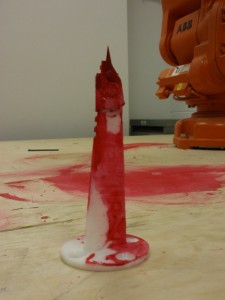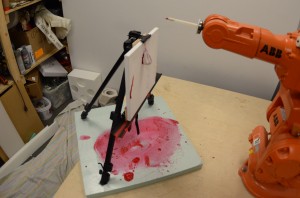Robo-Art
The concept of my project involves using the robot to create art in such a way that the robot itself can be seen as the artist, rather than as a tool in the creation process. When I initially approached this project, I decided upon the medium of paint as paint can be used in a much more expressive and less technical way than many other media I was considering. This is important because it means the final product cannot be predicted; to a certain extent, the product is out of the control of the human (and the robot). However, for the robot to really be seen as the artist, the process of creation seem inherent to the robot, whose motions are very calculated and precise. I found a way to combine these two ideas by teaching the robot its own version of balloon-dart painting. Balloon-dart painting involves filling balloons with paint, attaching them to a wall or a canvas, and throwing darts at the balloons to release the paint. Instead of teaching the robot to throw darts (which would mean teaching the robot a form of human painting and not a method of its own), I programmed in paths for the robot to use to pop the balloon at different angles using a knife tool. In the way the robot very technically creates a very expressive painting.
The following documentation is a series of tests of the robot popping the balloons at different angles. Each test involved attaching a single balloon filled with paint at the top center of a square canvas then securing the canvas on a easel so that the canvas was perpendicular with the robot’s table.
The tool I originally used was a 3D-printed tool in the shape of a knife. The knife-tool has a wider back and narrows into a blade with jagged teeth, with a sharp tip to pierce the balloon. However, I found out when I tested the knife-tool that the blade was not sharp enough to break the balloon open:
As such, I ended up taping an exacto blade to the end of the tool as a replacement tip for the original one to get that good initially first poke.
Before running the knife-swipe program on the balloons, I tested each of the swipe motions at two different speeds (v500 and v800):
Once I determined that each path would run smoothly without any joint errors, I set up the balloons and tried out the various cuts. For the first few, I tried both the v500 and v800 cuts, but it became quickly apparent that the v800 cuts were much more interesting:
I began with some swipes that when from the top right corner of the canvas to the bottom left: 0 degree rotation (straight down from the top middle of the canvas to the bottom middle), 30 degree rotation, 45 degree rotation, and 60 degree rotation. Here are examples of the 0 degree rotation at 800v (top) and the 30 degree rotation at 800v (bottom).
Then I decided to try out some more extreme angles of going straight across (both left to right and right to left) and of going from the bottom left corner of the canvas to the top right corner. Here are videos of the 90 degree rotation at v800 (top – swipe goes from right to left) and the 240 degree rotation at v800 (bottom):
In the end, I came out with 10 canvases with various cuts, some at different speeds:
The end goal of this exploration is to have a robot be able to detect balloons on a canvas, navigate to each balloon, choose a swipe and execute it, so that the robot is able to self-sufficiently create a painting on a large scale. The next steps would include: 1) doing more testing with multiple balloons on one canvas, with larger canvases, 2) attaching and programming a camera (or another detection device) onto the robot and teaching it to recognize unpopped balloons, and 3) programming the robot to (pseudo-)randomly decide how it would like to cut each balloon.





